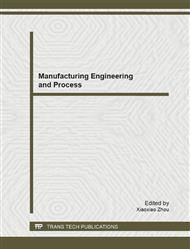p.3
p.11
p.15
p.20
p.26
p.31
p.39
p.47
p.52
Effect of Tool Edge Geometry on Cutting Force and Surface Roughness when Hard Turning Tool Steel
Abstract:
High usage of hardened steel in the automotive, gear, bearing, tool and die making industries, makes it a highly suitable material for industrial production and research. This study was undertaken to investigate the performance of coated ceramic insert with different edge preparations in terms of cutting force and surface roughness. Plain turning experiments were carried out under dry cutting condition at two different cutting speeds and feed rates with a constant depth of cut. The workpiece material is ASSAB DF-3 hardened steel with a 55 ±1 HRC hardness. Results showed that insert edge preparation had a direct influence on the radial and feed forces but not on the tangential force. The use of T-land edge preparation results in the lowest radial and feed forces. In terms of surface finish, the use of honed with finishing wiper insert results in obtaining the lowest surface roughness values. Feed rate had a significant effect on surface roughness whereby by increasing feed rate, the surface roughness value also increased, whereas the effect of cutting speed was found to be insignificant. Increasing cutting speed resulted in lower feed and tangential forces however by increasing feed rate all cutting forces increased.
Info:
Periodical:
Pages:
15-19
Citation:
Online since:
April 2012
Price:
Сopyright:
© 2012 Trans Tech Publications Ltd. All Rights Reserved
Share:
Citation:


